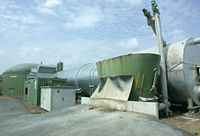
Photo from wikipedia
This study investigates the production potential of bio-crude from wastewater treatment high rate algal pond (WWT HRAP) biomass in terms of yield, elemental/chemical composition and higher heating value (HHV). Hydrothermal… Click to show full abstract
This study investigates the production potential of bio-crude from wastewater treatment high rate algal pond (WWT HRAP) biomass in terms of yield, elemental/chemical composition and higher heating value (HHV). Hydrothermal liquefaction (HTL) of the biomass slurry (2.2wt% solid content, 19.7kJ/g HHV) was conducted at a range of temperatures (150-300°C) for one hour. The bio-crude yield and HHV varied in range of 3.1-24.9wt% and 37.5-38.9kJ/g, respectively. The bio-crudes were comprised of 71-72.4wt% carbon, 0.9-4.8wt% nitrogen, 8.7-9.8wt% hydrogen and 12-15.7wt% oxygen. GC-MS analysis indicated that pyrroles, indoles, amides and fatty acids were the most abundant bio-crude compounds. HTL of WWT HRAP biomass resulted, also, in production of 10.5-26wt% water-soluble compounds (containing up to 293mg/L ammonia), 1.0-9.3wt% gas and 44.8-85.5wt% solid residue (12.2-18.1kJ/g). The aqueous phase has a great potential to be used as an ammonia source for further algal cultivation and the solid residue could be used as a process fuel source.
Journal Title: Bioresource technology
Year Published: 2017
Link to full text (if available)
Share on Social Media: Sign Up to like & get
recommendations!